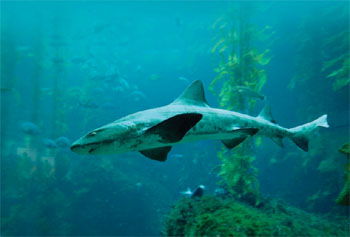Leopard Shark
Created on Day 5
on March 16, 2012Research indicates that the red blood cells of the leopard shark are smaller and more numerous than the red blood cells of other sharks.
Design

Research indicates that the red blood cells of the leopard shark are smaller and more numerous than the red blood cells of other sharks. This may provide the leopard shark the ability to more easily absorb oxygen from the water. It also has electroreceptors in its snout to help it locate buried prey, such as worms.
Features
- The leopard shark is most distinguished by the dark barbs on its dorsal fins.
- A young leopard has dark patches across its back and spots on its sides. As it ages it will usually lose these dark markings.
- Its body is long and slender and the adult has broad triangular pectoral fins.
Fun Facts
- The leopard shark is also called a cat shark.
- This shark is generally considered to be non-threatening to humans, and is most commonly found in muddy bays, including estuaries and lagoons.
- This shark is used for human consumption.
- The leopard shark is ovoviviparous and has four to 29 pups per litter.
CLASS: Chondrichthyes (cartilaginous fish—sharks, skates, and rays)
ORDER: Carcharhiniformes (ground sharks)
FAMILY: Triakidae (houndsharks, smooth-hounds, topes, and whiskery sharks)
GENUS/SPECIES: Triakis semifasciata
Size: Up to 7 ft (2.1 m)
Weight: 42 lbs (19 kg)
Diet: Crustaceans, fish, worms, clams, octopuses
Habitat: Shallow waters of the Pacific Ocean from Oregon to Baja, California
Aquarium Guide
This long-awaited Aquarium Guide includes beautiful pictures and reveals the incredible facts and design features that point to our amazing Creator.
Browse Kids Book- © 2025 Answers in Genesis
- Privacy Policy
- Contact
- About

